For Paul Rebich, a connection with the past is never far away. On any given day, four
generations of Rebich family history are right under his feet. For a hundred years, cattle
bearing his family's O-Bar-R brand have grazed the same fields just south of Dillon,
Montana. The rhythm of his work -- from calving season to haying season and back again --
is largely unchanged from his great-grandfather's time.
The 27-year-old rancher's future is also right here. In the trailer he and his wife
call home, he's slowly building an international cattle-breeding operation -- on the Net.
Ultimately, Rebich would like to run a Web-based, breeder-to-breeder virtual marketplace.
Technology of one sort or another has been at home here for a long time. For previous
generations, rural electrification and telephones spelled comfort, convenience and
economic opportunity. Today, the Internet is slowly creeping into the daily life of
Dillon, where an estimated 35 percent of the 4,004 residents are online.
While some in this cattle town see the Net as just one more strike against a hard-won
way of life, Rebich and others are finding novel ways to have the ``Big Sky'' lifestyle
and a digital future. In this corner of paradise, a tech revolution is
quietly being fought one person at a time.
Southwestern Montana is not an easy place to make a living. Rebich, who routinely puts
in 12-hour days on the ranch, pays himself a salary of $800 a month. It's no mystery why
he would hustle so hard to have a life here:
Beaverhead County, cradled on three sides by the Continental Divide, is one of the last
best unspoiled regions of a state that calls itself ``The Last Best Place.'' The trophy
trout, the alpine meadows so green they'll make your eyes ache, the whole ``Big Sky
Country'' riff -- it's all true.
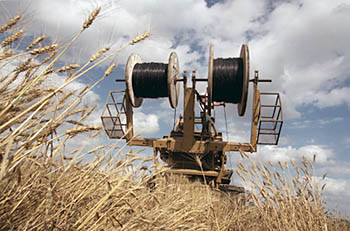 |
|
| In the middle of a wheat field,
road crews install fiber optic cable that will help provide Internet service to the rural
West, where national Internet service providers like America Online and Earthlink are not
available. |
|
Hand-sewn dustcovers
Two retired teachers launch Dillon-Net
Ken and Nellie Bandelier spent much of their careers in Dillon working on the bleeding
edge of computing. Between the two of them, you could say they have more than 40 years of
accumulated geekitude. Nellie, a former elementary school teacher, and Ken, a former
biology professor at Western Montana College in Dillon, were both using computers in their
classrooms back in the bad old days when the only educational software available was the
stuff you wrote yourself.
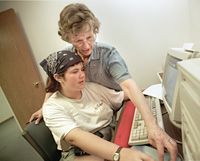 |
|
| Dillon-Net founder Nellie
Bandelier helps a young client with e-mail at the agency's main office. |
|
After the Bandeliers retired in 1988, Ken kept a hand in the digital world. Five years
ago, after they secured a home dial-up Internet account through the college, Nellie
started writing an Internet column for the Dillon Tribune. Before long, she was inviting
readers to meet at her house to share ideas about how the Net might help their community.
Less than a year after Nellie started the column, the Bandeliers launched Dillon-Net
with a single computer donated by United Way.
Today the community technology center provides public-access terminals and training at
10 sites in town and 14 locations in nine outlying communities. The smallest Dillon-Net
outpost is in the school in the town of Grant (population: 6). In truth, Dillon-Net is
more of a loose confederation than a network. The central office of Dillon-Net supplies
basic training and some ongoing support, but each individual outpost must provide
everything else -- volunteers, Internet service and electricity. The central
organization's annual budget: $10,000.
The shoestring success has not escaped notice in the world beyond southwestern Montana.
Dillon-Net has been a finalist two years running in the AOL Foundation's Rural
Telecommunications Leadership Awards. It has also picked up honors in a Swedish telecom
project competition.
Dillon-Net central is two rooms in the back of the ``English Professional Building,'' a
reconfigured cinder-block gas station now shared by a doctor, a dentist and an
optometrist. Like just about every other private non-profit in the country, it's
overcrowded with mismatched hand-me-down furniture. The seven computers -- each of which
sports its own dustcover hand-sewn by students at the high school -- all share a single
56K data line.
 |
|
| Dillon-Net co-founder Ken
Bandelier performs some maintenance outside Dilllon-Net headquarters. |
|
About 100 Dillon residents get individualized help at the main office each week. The
Dillon-Net style of instruction could best be characterized as viral: A volunteer shows a
new Web-authoring trick or application to Nellie, who teaches one of the schoolkids who
are usually hanging out in the afternoon, who teaches the local artist, who teaches
. . .
``A lot of people who walk through that door have never touched a computer before,''
says Glenna King, the local United Way executive director, who puts in weekly stints as a
Dillon-Net volunteer. ``They say: `I want to get on the Internet. Can we do that today?'
We can try. We start by learning how to work the mouse.''
Buying tractor parts
'The Big Hole' meets the killer app
To see a community that's considered remote by Montana standards, head west from Dillon
over 40 miles of sometimes-paved road, cross two mountain passes and drop into the Big
Hole Valley, referred to by everyone hereabouts as simply ``The Big Hole.'' When you see
some buildings by the side of the road, you are in downtown Jackson (population: 35 people
and 18 dogs). On the left, in the weathered 103-year-old IOOF hall, lives the Big Hole's
ambassador to the digital world, Judy Halazon.
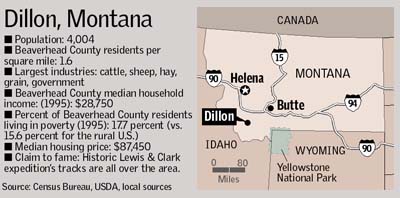 Halazon, a successful graphic artist until multiple health problems put her on permanent
disability in 1994, met Nellie Bandelier four years ago, just as Dillon-Net was taking
off. ``I'd never even turned a computer on -- not any computer,'' she recalls.
``And I just looked at her for the longest time and thought, `C'mon, honey, this is not my
ball of wax.' '' But it was. A basic Windows PC in the corner of Halazon's joyously
cluttered living room is Jackson's Dillon-Net outpost.
Halazon, a successful graphic artist until multiple health problems put her on permanent
disability in 1994, met Nellie Bandelier four years ago, just as Dillon-Net was taking
off. ``I'd never even turned a computer on -- not any computer,'' she recalls.
``And I just looked at her for the longest time and thought, `C'mon, honey, this is not my
ball of wax.' '' But it was. A basic Windows PC in the corner of Halazon's joyously
cluttered living room is Jackson's Dillon-Net outpost.
At the ragged edge of civilization, in places like the Big Hole, it is flat-out
impossible to get away from humanity. You don't have to like your neighbors, but you need
them. People watch out for each others' kids and animals. Literally or figuratively,
Jackson's residents mind their neighbor's business. ``Everybody helps everybody out
here,'' says Halazon.
Over four years, Halazon has found a new role for herself as the den mother to the Big
Hole's budding digital elite. Ranch families from up and down the valley, migrant workers
and bike tourists passing through the region all rely on her for guidance and a line out
to cyberspace. When they can't come into town, they call and Halazon reads them their
e-mail.
 |
|
| Many ranch families rely on Judy
Halazon, left, for their link to the Internet. When they can't come to Jackson, Mont., to
see her in person, they call and Halazon reads them their e-mail. |
|
``It gives me something to do,'' says Halazon. ``When I first started this, with the
multiple sclerosis, I didn't know if I'd get the hands back. I couldn't get up and down
the stairs. There was a lot of information and support on the Internet. I'm one of the
lucky ones with remitting MS that might never come back again.''
Halazon's unpaid job is to make the Internet relevant in a place where the main
enterprises -- chasing cows and putting up hay -- haven't changed very much since the
arrival of the telegraph. She's been called on to advise and assist on everything from
marketing the work of local craftspeople to relaying messages for stranded travelers.
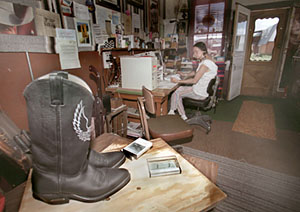 |
|
| Judy Halazon mans the Cyberian
Outpost, 40 miles west of Dillon. |
|
Although it took a couple of years for Jackson to warm to the Internet, the word is out
that this is something of practical value. A killer app for the typical Dillon-Net
customer in the Big Hole: express-shipped tractor parts. ``It's sinking in with people
that they can get a better price, they can see what they're getting and they don't have to
waste the time driving,'' says Halazon. ``With these tractors, some are 2 years old, some
20 years old, 15 different brands, and when something goes haywire you end up calling all
over the country trying to fix it. Bingo, you get it on the Internet and it just amazes
them.''
At the time Halazon set up shop she knew of just three Internet-connected computers in
the Big Hole, which she guesses has a population of about 150. Now, she figures 25 or 30
residents who used to rely on the Dillon-Net machine have gone on to procure their own.
|
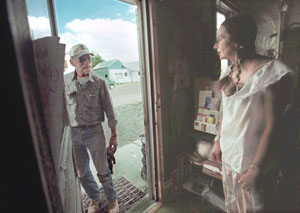 |
|
Judy
Halazon chats with a neighbor in the tiny burg of Jackson, a suburb of Dillon. |
Halazon's Dillon-Net outpost cost $1,674 to operate in 1999 -- most of that going to
paper and printer cartridges. Internet access and phone charges through the local
mom-and-pop operator, Southern Montana Telephone, run $32 a month. She gets about $75 a
year in donations. The rest is out of her pocket. As she is quick to point out, people are
used to getting by under less-than-ideal conditions out here. She does wish she could get
more RAM, though. She's been waiting six months and there just isn't anyone to make the
drive out from Dillon to put it in.
Online 'revelations'
Ranch job hunt; shoppers have choices
As is probably the case in the rest of America, the No. 1 driver for getting rural
residents to make that initial foray into the wired life is family communication. Digital
culture amplifies and extends networks that are already important in people's lives.
And right behind family e-mail is shopping. It would be hard to overestimate just how
much of a social leveler e-commerce has been for rural folk who have never had access to
the selection and competitive pricing of suburban malls. When a routine shopping trip to
Butte, 40 miles away, can burn half a day, as one Dillon resident put it, ``you get to
love Amazon. To be able to get a book in two days is almost a revelation in this town.''
Halazon says the Net has particular value for the ranch hands who typically work six
days a week and often lack the transportation to get into even Dillon. ``It's either rich
or poor here, there's no in-between in this area. You either own the ranches or you work
on them,'' she says. ``I have ranch hands -- they generally make $400 a month plus room
and board -- come in and use the computer to get better jobs elsewhere.''
For Dillon, the virtual world's economic impact hasn't been easy to spot. There is a
growing (but hard to quantify) tourism component to the local economy -- fly-fishing
outfitters, dude ranches and guides -- that's using the Web to market Dillon to the world
outside Montana. But actual e-commerce appears to be limited to a handful of individuals
selling crafts and that class of pseudo-collectible known sub rosa as ``junk we found in
the barn'' on eBay.
Wheat and fiber
Bakers thrive with little bandwidth
When it comes to using the Net as a business tool, the most conspicuous model is the
Great Harvest Bread Company. Pete and Laura Wakeman, a pair of late-model hippie
capitalists originally from Connecticut, founded the bakery in 1975 and then switched from
making bread to franchising bakeries three years later. Today Great Harvest is a closely
held empire of 140 bakeries in 40 states, with $60 million in annual sales.
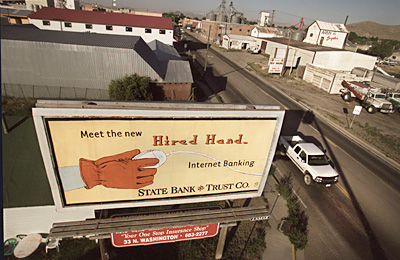 |
|
| The Internet is literally
changing the face of the rural West, as shown by this billboard on Dillon's main street. |
|
Franchising is a quintessential information-intensive business, one that's usually run
on the old command-and-control model from headquarters. Great Harvest, on the other hand,
is largely a network of peers. Seven years ago, that network began moving away from
newsletters and telephones to computers, first over the CompuServe online system and now
via the Web and e-mail. Today three of the 27 people in the Dillon home office work in Web
operations.
``We teach people how to set up and run great little whole-wheat bakeries. Think of us
as a for-profit university,'' says Great Harvest Chief Operating Officer Tom McMakin. It's
not a purely virtual corporation but rather a brick-and-mortar company with a virtual
strategy at its core, he explains. As owners share information from recipes and training
advice to marketing strategies, the private Web site's discussion archives are slowly
growing into the institutional memory of the organization. ``What we've done is spend just
about all our energy and resources linking together a giant learning community,'' says
McMakin.
By Dillon standards, Great Harvest provides premium-quality jobs. Mining and timber
have been in decline for many years with no realistic hope that they're coming back.
Cattle ranching, grains and hay -- risky businesses even in good times -- are what keep
the region running. Beaverhead County's median income is 16 percent below the national
average, and it's not uncommon to see people working two or three part-time, $7-per-hour
jobs to get by.
If another Net-dependent employer offering high-wage jobs like Great Harvest were to
consider locating in Dillon today, it would probably decide to look elsewhere. Qwest
(formerly U S West), the monopoly phone carrier in town, has a critical
bandwidth shortage in the county. Because Qwest's lines from Dillon to Butte are full, the
local Internet service provider and seven other businesses and institutions endure long
waits for high-capacity T-1 lines.
Rather than invest approximately $3 million to run fiber-optic cables along the 40-mile
route, Qwest recently struck an agreement with Three Rivers, the independent phone company
in the neighboring territory. Three Rivers is extending its fiber network to Dillon and
may begin carrying traffic to Qwest's facilities in Butte as early as next month.
Staying put
Like listening to 'a tree full of magpies'
Beaverhead County, Montana's largest, covers over 3.5 million acres -- 5,500 square
miles. That makes Garth Haugland the top government executive for a territory nearly as
large as Rhode Island and Connecticut combined. The burr-cut former game warden and
wildland firefighter who chairs the Beaverhead County Commission is also the rarest of
political creatures -- an elected official incapable of spin.
|
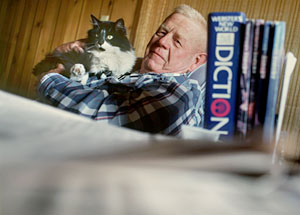 |
|
"We're
being pushed to e-government," says Garth Haugland, the top government executive in
Beaverhead County. He says his constituents "don't want to talk to a machine. They
want to talk to that lady behind the counter." |
The chances of Haugland uttering a disingenuous word are about equal to the chances he
will show up for the next commission meeting sporting a ponytail and an earring. This
blunt, you-heard-it-from-The-Man quality has earned him the grudging respect of some
rather diverse audiences. When 30,000 New Age vagabonds tripped into Beaverhead County for
the Rainbow Family Gathering this summer, the Rainbows -- no fans of authority figures --
christened him ``Big Dog.''
Haugland, not the type to be easily pushed around, is feeling some pressure these days.
He says the pressure to take Beaverhead County government into the Internet age is not
coming from his own constituents. ``We're being pushed to e-government, being pushed
nationally and by the Montana Association of County Officials,'' he says. ``I've talked to
a lot of people who come in here and want some information. They don't want to talk to a
machine. They want to talk to that lady behind the counter. Now how are we going to do the
Internet if we can't even get the phone system to work? That's reality.''
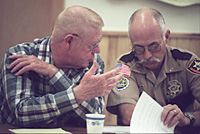 |
|
| Garth "Big Dog"
Haugland, left, chairman of the Beaverhead County Commission talks with a constituent at a
county commission meeting. |
|
What has the Internet really meant to Dillon? ``I don't know,'' he says, shaking his
head slowly. ``I don't deal much in that. Nellie Bandelier, she gets to chattering like a
tree full of magpies over this stuff and I tend to mentally tune her out.'' Haugland tried
a computers-for-dummies course once at the college. ``Within an hour, I was so far behind
I excused myself and didn't go back,'' he says. ``I honestly don't have an interest in
it.''
Talk in the commission chambers turns to how the children of Dillon, raised with
computers in the home, will be natives in the digital world whereas their parents shall
always be immigrants. Big Dog lets fly with a fat stream of chewing-tobacco juice and
gazes out the courthouse window toward downtown. ``I don't plan to immigrate,'' he says
flatly.
Pace of change
Slow is faster than `not in my lifetime'
Haugland's jaundiced view is probably the majority sentiment in Dillon. While a
significant contingent of their neighbors is on the Net -- about the same proportion as
anywhere else in rural America -- many people here don't see any relationship between
digital technology and their lives.
What's behind the ambivalence? First, this has always been a place where the pace of
change is somewhere between slow and ``not in my lifetime.'' Farmers are still divided
over the switch from rectangular hay bales to round. And there are a lot of people who
moved here for what Dillon isn't. It isn't Silicon Valley. It isn't Seattle. And it isn't
the kind of yuppified, BMW-driving Boutique Montana scene that many believe has ruined the
Bitterroot Valley.
The real network infrastructure of Dillon has nothing to do with the Net. On a busy
Friday night at Las Carmelitas, you could spend 10 minutes getting from one side of the
one-room restaurant to the other. That's about what it takes when every other table is
occupied by a neighbor, a client, your sister's bridesmaid from 20 years ago or that best
friend from third grade. In Dillon, network access means you get the real estate and
cattle news first -- from an old man sitting in a muddy pickup truck in front of the post
office. This is a place where you ask for a phone number and they give you four digits. If
you don't know the missing ones by heart, then you don't have network access in Dillon.
``A lot of folks who live here do so because it is the way it is, and they don't want
to see that change,'' says Dillon-Net volunteer King, an Indiana native. ``A lot of people
are afraid this computer technology is just going to bring in a lot of stuff that they
moved away from -- hectic lifestyle, high stress. Folks here don't want it. People here
are certainly not backward, but I do think they're cautious as to what's brought in. What
they're really guarding is the quality of life.''
Nobody in Dillon knows more about cultural barriers to new technology than Frank Odasz,
the Johnny Appleseed of community networking. The former oilfield roughneck and dude ranch
manager founded the legendary Montana education network Big Sky Telegraph in 1988 and
spent the next 10 years delivering training over slow 2400-baud modems to rural educators
in more than 100 one- and two-room schools.
These days, when he isn't preaching self-empowerment and digital culture to
marginalized groups ranging from impoverished youths in Mississippi to Eskimo communities
above the Arctic Circle, he's here in Dillon.
``The general mentality is that the Internet is a time-wasting toy, best suitable for
kids,'' says Odasz. ``There are real-world issues -- cutting alfalfa, water shortages,
forest fires -- and the Internet doesn't address the physical realities of what most rural
life is about. People need to see models that relate to them and are replicable for them.
``The idea of sitting in front of a computer from 8 in the morning till 5 in the
evening sounds like the death knell to the lifestyle and sense of personal pride these
people have,'' he says.
Even if a dozen Web-based companies lined Dillon's main drag, cattle, alfalfa and hay
would still be the foundations of Beaverhead County for a long time to come. Four years
ago, John Maki, the county agricultural extension agent, teamed up with Barrows and Odasz
and convened a town meeting to explain how the Net might enhance the lives of Dillon
residents. Today, Maki guesses that 20 percent of the ranchers are on the Net. Most of
those who have computers, he says, are just using them for record-keeping.
Beefalo B-to-B
Silicon Valley mindset in Big Sky Country
If there is one person who has a fighting chance to break through the agricultural
world's indifference toward all things Internet, it's Rebich, the fourth-generation
rancher with one boot firmly planted in the proud traditions of Old Dillon and the other
in cyberspace.
|
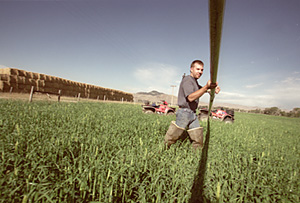 |
|
Fourth-generation
Dillon rancher Paul Rebich works in his hayfields. |
He isn't killing time, waiting as the reins of the family empire gradually pass into
his hands and those of his brother. Rebich, an entrepreneurial soul who would be right at
home in the venture-cap jungle of Silicon Valley, has other things on his mind. There's
the set of cabins he'd like to get going to capitalize on the world-class trout streams
that pass through his land. And there's his own business, Big Sky Beefalo.
Rebich figures beefalo, a cattle crossbreed containing three-eighths buffalo genes, is
just the ticket for health-conscious carnivores who will pay premium prices for super-lean
meat. Instead of selling his small herd for slaughter, he wants to concentrate on
developing superior bloodlines and selling stock, embryos and frozen bull semen to other
breeders. And the key to marketing the breeding venture is www.beefalobeef.com.
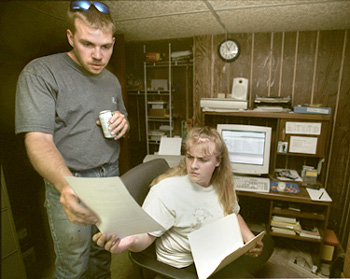 |
|
| Paul Rebich and Tina Morris, his
sister, monitor e-mail from potential buyers of their family's beefalo. |
|
The no-frills site, designed by Rebich and his wife, Kimberly, is as much a learning
experiment as it is a commercial venture. While the Internet amounts to less than 1
percent of his total annual revenues from beefalo, traditional cattle and hay, fully 80
percent of the breeding business is already coming from the Net.
The biggest international response so far is from Australia. ``That's a tough, tough
country,'' Rebich explains. ``The cattle have to be very hardy. Beefalo is very
interesting to them for that reason.'' It's entirely possible that the small herd grazing
on Rebich land five miles south of Dillon will eventually be the primary genetic stock for
most of the beefalo in Oz.
Rebich is not the only rancher dabbling in beefalo -- and that may lead to his next
venture. There are between 200 and 300 beefalo breeders around the country and today they
keep in touch through two large registry organizations. It's Rebich's hope to someday
organize them into a Web-based marketplace and registry. ``Most of those people are still
in an agricultural frame of mind. I'm stepping out on a limb a bit to do the
registry online and try to connect those breeders,'' says Rebich, ``but I believe in the
long run it's going to help my operation.''
|
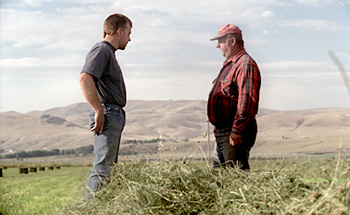 |
|
Paul
Rebich tells visitors to his Web site that he wants to keep alive the business his father
and his Uncle Phillip, right, ran in Dillon. In addition to raising cattle, the family
tends to fields of hay. |
As Rebich squires a visitor across the marshy fields in his pickup, he runs through
where he's going and where he wants to be -- all the angles, all the possibilities out
there just waiting to be tested. Beefalo or not, you just know this guy isn't going to
rest until he finds a way to come out on top.
Wide open future
Dillon will change as much as it wants
In terms of a digital future, Dillon is holding some winning cards -- Dillon-Net is a
nationally renowned success story, as is Great Harvest Bread Company. Every day Judy
Halazon and a legion of other volunteers are using the Net to give some of the most
isolated people in the country small comforts most of us take for granted.
While digital culture slowly weaves its way into the fabric of daily life, it hasn't
overwhelmed Dillon. Nor has it threatened the proud ranching culture that came before.
Indeed, as much as it may vex an outsider to admit it, much of old Dillon is working just
fine without the Net.
Contact David Plotnikoff at plotnikoff@sjmercury.com or (408) 920-5867.
Photos by Pauline Lubens, Mercury News staff
photographer.
Posted October 29, 2000.


![]()

